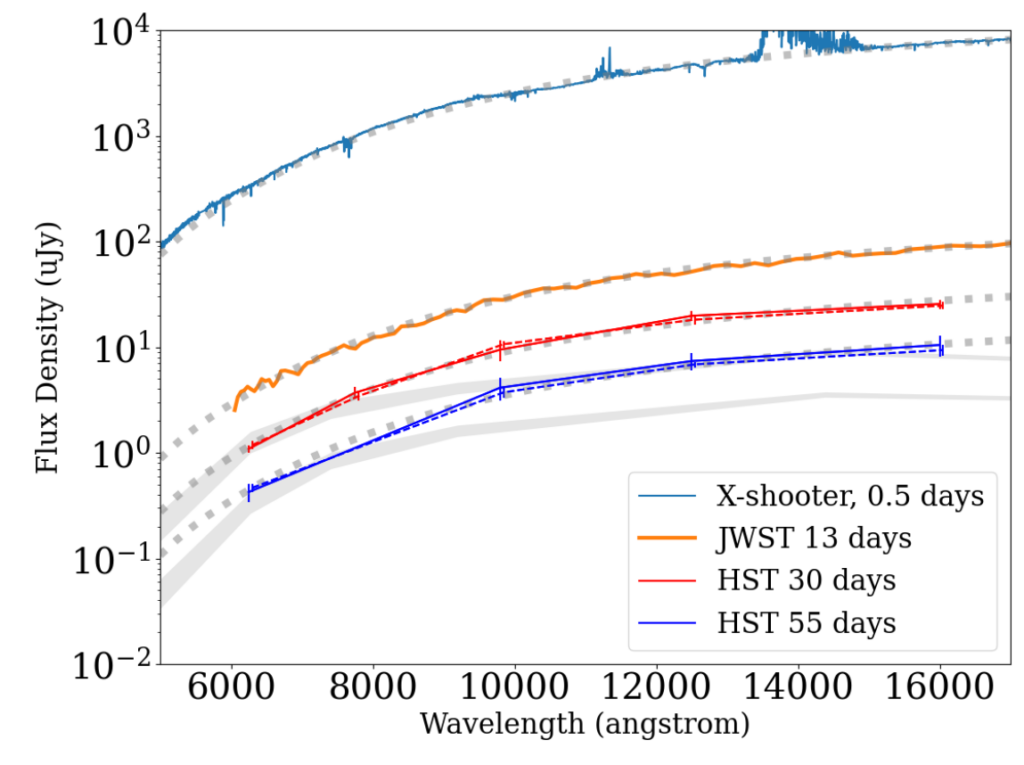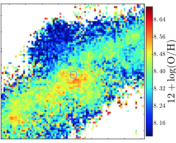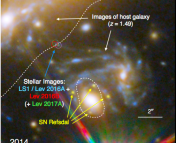Authors: A.J. Levan, G. P. Lamb, B. Schneider, et. al (54 additional authors)
First Author’s Institution: Department of Astrophysics/IMAPP, Radboud University, The Netherlands
Status: Submitted to the Astrophysical Journal Letters [closed access]
In October of 2022, a shockingly bright explosion of high-energy light was detected by several telescopes. This flash was a gamma-ray burst (GRB): a powerful explosion of gamma rays, the highest-energy form of light. Named GRB221009A for its discovery on the 9th of October 2022, this burst is the most luminous of 10,000 GRBs recorded over 50 years. Follow-up observations of the region showed that this burst was closer to Earth than the typical GRB, giving astronomers the ability to get a uniquely detailed look at the GRB’s lingering afterglow as well as the flash’s galaxy of origin.
The authors of today’s paper used the new James Webb Space Telescope (JWST) as well as the Hubble Space Telescope (HST) to obtain spectra of the afterglow in the optical and infrared wavelengths of light. A spectrum is a measurement of the energy of light emitted at different wavelengths, and can clue us in to what kind of emission processes are taking place as well as the makeup of the object radiating the light. Today’s authors collected spectra starting half a day after the initial GRB continuing to 55 days post-burst, and used photometric observations to gain information on the GRB’s host galaxy. Even more exciting, the use of the MIRI instrument on the JWST marks the first mid-infrared spectroscopy of a GRB!
GRBs come in two types: short-duration bursts typically caused by the merger of two compact objects, and long GRBs usually associated with supernovae. GRB221009A is of the long-duration variety, and previous studies have found some evidence of a possible supernova correlation, but it’s hard to draw unambiguous conclusions. Although the burst was relatively close by, in order to observe it we need to look through a particularly dense region of our own Milky Way galaxy. Any analysis of the data we take would need to subtract the contribution from the stars, gas, and dust in our own galaxy and get that correction exactly right. This is true in the optical and infrared wavelengths that today’s authors use, but even X-ray observations are complicated by the dusty halo in our own galaxy!
GRB221009A’s Hometown

Figure 1 shows photometric images taken of the afterglow with the JWST (left) and the HST (right). In the Hubble image, the host galaxy can be seen as the ‘smudge’ extending across the central GRB. These observations show that the galaxy is disc-like, and that the burst originated close to the center of the galaxy (but not perfectly aligned with the center). The galaxy is actually fairly standard for long-duration GRB hosts, being lower mass and smaller than a typical host galaxy is for a short-duration burst. In fact, the galaxy is actually so regular it’s mystifying– it means that this extraordinarily bright GRB is not special because of its environment, and something else must be the driving force behind its high luminosity.
A Hidden Supernova?
The authors were able to obtain very precise spectra of the GRB region using the JWST and HST; Figure 2 shows the spectra taken with the X-shooter telescope as well as the other two telescopes. Notice that the flux density decreases as time goes on– this is the GRB afterglow slowly dimming over time. These spectra are remarkably stable over time, more stable than we would expect if a supernova took place, which is usually the expected mechanism behind long GRBs like this one. If a supernova explosion had taken place, we’d see that over time (especially in the Hubble spectra) the spectrum would be more influenced by that and less by the afterglow. This is shown in the gray shaded curves, which are the spectra of a previous GRB with a supernova association– you can see that above wavelengths of ~8000 angstroms, the emission from this GRB does not match up at all with the supernova-affected spectra. Here, the lack of obvious spectral evolution over time means that if there was a supernova, it could not have been substantially bright to be detected in these wavelength regions.

The lack of evidence for a supernova in this case stands out for a few reasons. First, it’s at odds with earlier studies which did find evidence that a supernova may have taken place. We also know that this is a long-duration GRB, which are more often than not associated with supernovae, and we would expect that the brightest GRB ever observed would be correlated with supernovae (the brightest astronomical explosions we can observe). While the observations in today’s paper are more sensitive and have better wavelength coverage than past studies, the previously mentioned difficulties in getting any observations of this region means that all of these measurements and theories come with a great deal of uncertainty.
Today’s authors used the brand-new JWST to observe the brightest GRB ever observed– you would expect this would lead to easy clear-cut science, but it raised more questions than answers! Unlike previous studies, there was no evidence for a supernova having taken place– we can’t rule one out, especially given the observational challenges involved, but it leaves a mystery as to the source of this GRB. Furthermore, the host galaxy of GRB221009A was found to be….totally average. There was nothing special about the galaxy or the GRB’s position inside of it– we’ll need to follow up this source even more to find out the engine behind this ultra-energetic burst.
Astrobite edited by Lucie Rowland
Featured image credit: formulanone




